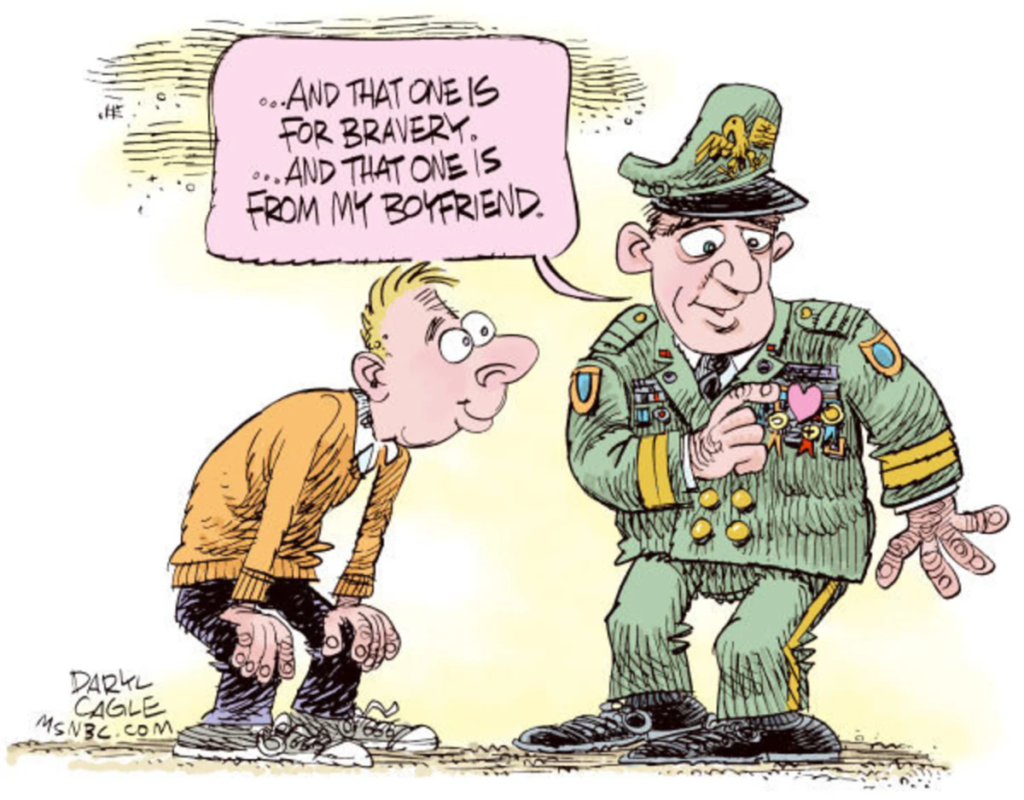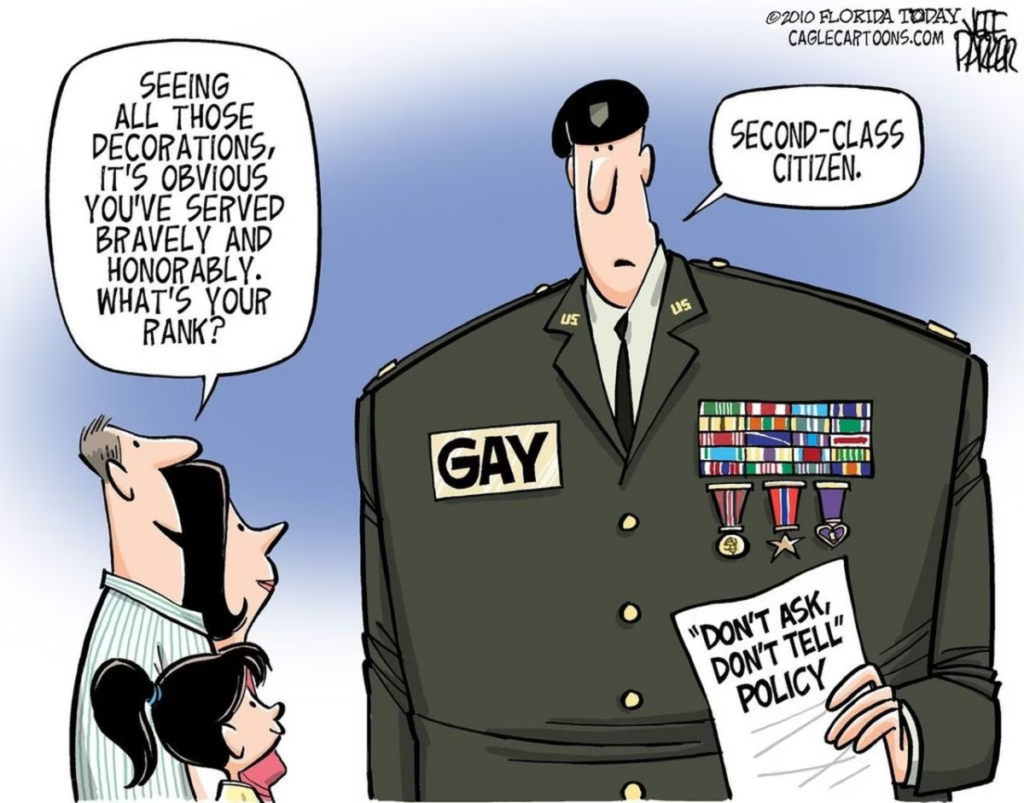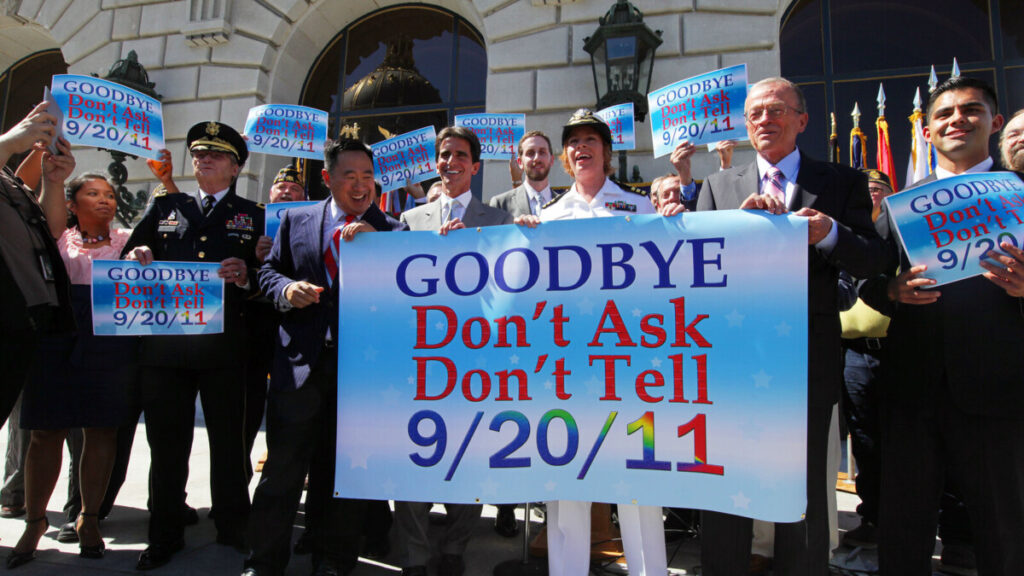Overview
“Don’t Ask, Don’t Tell” (DADT) was the official United States military policy regarding the service of non-heterosexual in the military. This policy prohibited military personnel from discriminating or harassing closeted homosexual or bisexual service members. However, the policy also prevented openly gay, lesbian, or bisexual individuals from serving in the military. In essence, the DADT policy ensures that gay, lesbian, and bisexual individuals could serve in the military as long as they did not disclose their sexual orientation or engage in homosexual activities.
History
The “Don’t Ask, Don’t Tell” military policy originated in 1993 during the Clinton administration as a compromise intended to allow LGBTQ+ individuals to serve in the US military without fear of being discharged solely for their sexual orientation. The introduction of the DADT policy marked a significant shift in military policy regarding LGBTQ+ service members. Prior to the implementation of DADT, the military had an outright ban on LGBTQ+ service members under the premise that homosexuality was incompatible with military service.
DADT was formulated as a way to allow LGBTQ+ individuals to serve so long as they kept their sexual orientation private. Under the policy, applicants were not allowed to be asked about their sexual orientation during the enlistment process. Once enlisted, LGBTQ+ service members were expected to keep their orientation to themselvesto avoid the risk of discharge. The establishment of DADT was the result of a compromise that emerged from negotiations between the Clinton White House and military leadership, who were resistant to allowing open LGBTQ+ service.
The DADT policy was signed into law via the National Defense Authorization Act in 1993, following lengthy congressional hearings and debate. Supporters claimed it would improve conditions for LGBTQ service members compared to the prior ban, while critics argued it merely codified discrimination by forcing secrecy. This division in opinion is underscored by the policy’s tangible impact: over a span of nearly two decades, DADT led to the discharge of over 13,000 troops for violating its restrictions.
After extensive review, DADT was repealed under the Obama administration in 2011, allowing for open LGBTQ service. However, the origins and history of DADT illustrate the contentious path toward ending institutionalized discrimination against LGBTQ+ individuals in the US military. The policy itself became a symbol of the tension between efforts toward equality and ingrained resistance to change. Over time, DADT came to symbolize a broader societal struggle concerning LGBTQ+ rights and acceptance, particularly within hierarchal and traditional-bound institutions like the military.
Examples
DADT and Public Opinion
The DADT policy was a subject of intense debate and varying public opinions throughout its tenure. The public’s stance on the issue was influenced by numerous factors, including political affiliations, religious beliefs, and societal attitudes towards LGBTQ+ rights.
Public opinion was deeply divided in the early years of the policy. Conservative and religious groups largely supported DADT, viewing it as a necessary compromise to uphold military discipline and morale. On the other hand, LGBTQ+ advocacy groups, liberal organizations, and a growing segment of the American population challenged the policy, criticizing it as discriminatory and unjust.
As the years progressed, public opinion experienced a significant shift, with increasing support for allowing LGBTQ+ individuals to serve openly in the military. National polls and surveys reflected this change in sentiment. A Gallup poll conducted in 1993 found that 57% of Americans supported allowing openly gay individuals to serve in the military. By 2010, this number had increased to an overwhelming 77% (Gallup 2010). This transformation in societal attitudes indicated a broader change in how Americans perceived LGBTQ+ rights and their role within pivotal societal institutions, including the military. It also represents a major cultural shift towards inclusivity and equal rights over a relatively short span of time.
Several factors contributed to this shift in public opinion. First and foremost was the broader societal movement towards acceptance and equal rights for LGBTQ+ individuals. This movement was characterized by a surge in visibility for LGBTQ+ issues, legislative strides in favor of equal rights, and a cultural shift that increasingly embraced diversity and inclusion. As society became more accepting of LGBTQ+ rights, the rationale behind DADT began to crumble, appearing increasingly out of step with societal values. The division between the policy and the prevailing attitudes towards LGBTQ+ equality became too stark to ignore, prompting calls for change from various sectors of society.
The visibility of LGBTQ+ service members also played a crucial role in changing public attitudes. Despite the risks, some service members chose to come out publicly, sharing their stories and highlighting the injustice of DADT. These brave individuals transitioned the issue from an abstract political matter to a tangible problem. Their stories revealed the human cost of discrimination and galvanized public support for change.
Media coverage was another influential factor, as news outlets and journalists brought the issue to the forefront of public discourse. The media played a pivotal role in shaping perceptions, providing a platform for the voices of affected service members, and fostering a national conversation about the policy and its implications.
By the time of its repeal in 2010, DADT had become largely unpopular, with the majority of Americans recognizing the policy’s inherent injustice and its detrimental impact on military readiness and integrity. The repeal marked a victory for LGBTQ+ rights and equality, reflecting a transformed societal landscape and a more inclusive vision of military service.
The evolution of public opinion on DADT serves as a testament to the power of advocacy, visibility, and the ability of society to evolve and embrace inclusivity. Understanding this journey is crucial, as it provides valuable insights into the dynamics of social change, the importance of visibility, and the ongoing quest for equality and justice.
In conclusion, the story of “Don’t Ask, Don’t Tell” is one of resilience, transformation, and the relentless pursuit of justice. The policy’s impact on LGBTQ+ service members, the military institution, and broader societal attitudes serves as a profound reminder of the power of advocacy, the importance of visibility, and the potential for change.
DADT and Challenges
The DADT policy presented a series of complex challenges, affecting both the targeted individuals and the military institution as a whole. Introduced as a compromise, the policy was filled with contradictions and unintended consequences that undermined its initial intentions.
One of the most immediate challenges was the impact on military cohesion and morale. Proponents of DADT argued that it was necessary to maintain unit cohesion, but in reality, the policy fostered an atmosphere of mistrust and discrimination. Dr. Nathaniel Frank, a distinguished scholar on military and LGBTQ+ issues, explains that “the policy created an atmosphere of paranoia and discrimination, undermining trust and cohesion within units” (Frank, 2009). Instead of fostering unity, DADT created divisions, as service members were aware that their careers could be jeopardized if their sexual orientation was discovered. This fear of exposure and the constant vigilance required to maintain secrecy added an additional layer of stress and isolation for LGBTQ+ service members.
The loss of talented and skilled personnel was another significant challenge posed by DADT. Thousands of service members were discharged under the policy, resulting in a drain on military resources and capabilities. A report by the Government Accountability Office (GAO) estimated that the military spent over $190 million on recruiting and training costs to replace those discharged under DADT between 1994 and 2003 (GAO, 2005). This financial burden, coupled with the loss of experienced personnel, highlighted the inefficiency and detrimental impact of the policy on military readiness.
Moreover, DADT challenged the very values and integrity of the military institution. The policy required service members to live a lie, concealing their true selves, which was in direct contradiction to the military’s core values of honor, integrity, and duty. Admiral Mike Mullen, then Chairman of the Joint Chiefs of Staff, eloquently addressed this issue during his testimony before Congress, asserting:
“No matter how I look at the issue, I cannot escape being troubled by the fact that we have in place a policy which forces young men and women to lie about who they are in order to defend their fellow citizens.”
Mullen, Michael. “Testimony Before the Senate Armed Services Committee.” U.S. Senate, 2 Feb. 2010. Web. https://www.armed-services.senate.gov/imo/media/doc/Mullen_02-02-10.pdf.
Mullen’s statement highlighted the moral and ethical dilemma posed by DADT, drawing attention to the discord between the policy and the values it purported to protect. Such discord reflected the need for policy reevaluation and repeal.
The challenges of DADT extended beyond the military, affecting broader societal attitudes and perceptions of LGBTQ+ individuals. The policy perpetuated stigma and discrimination, contributing to a culture of silence and invisibility. It took a concerted effort from advocacy groups, supportive lawmakers, and allies to challenge and ultimately repeal the policy.
In reflecting on the challenges of DADT, it becomes evident that the policy was a flawed compromise, one that caused lasting damage and left deep scars. The repeal of DADT in 2010 was a critical milestone, but understanding these challenges remains vital. It serves as a reminder of the importance of integrity, inclusion, and the ongoing fight for equality within the military and society at large.
DADT and Mental Well-Being
“Under the new policy, I was still forced to keep my personal life hidden or risk losing my job. I was alone in a crowd.”
Belkin, Aaron. “”Don’t Ask, Don’t Tell”: Does the Gay Ban Undermine the Military’s Reputation?” Armed Forces & Society 34.2 (2008): 276-291
The DADT policy had profound implications on the mental health and well-being of service members affected by this regulation. Forced to hide their sexual orientation, many LGBTQ+ individuals serving under DADT experienced chronic stress, anxiety, and a host of other mental health issues.
The policy required a constant performance, as service members had to vigilantly monitor their behavior, relationships, and even speech, to avoid any suspicion regarding their sexual orientation (Meyer 2011). This enduring hyperawareness and effort to maintain a facade was psychologically draining, creating an environment where mental health issues could flourish. The strain was further intensified by the isolation many LGBTQ+ service members felt, as they were unable to seek support from peers or superiors without risking exposure (Burks, 2011).
Research conducted during and after the DADT era has consistently shown that the policy had detrimental effects on the mental health of LGBTQ+ service members. A study published in the American Journal of Public Health found that gay and lesbian service members were at an increased risk for mental health disorders, substance abuse, and suicidal ideation, compared to their heterosexual counterparts (Ramchand 2011). These results underscore the tangible mental health disparities fostered by the DADT policy, highlighting the urgent need for support and intervention.
The policy’s negative impact on mental health also extended to post-military life. Veterans who served under DADT reported ongoing mental health challenges, with many struggling to reconcile their military experience with their identity (Mattocks 2014). The lack of a supportive community and the stigma surrounding LGBTQ+ identities within the military created lasting psychological scars, affecting their transition to civilian life and overall well-being.
Challenging the DADT policy and advocating for the mental health of LGBTQ+ service members became a crucial aspect of the broader fight for LGBTQ+ rights. Numerous advocacy groups, mental health professionals, and supportive lawmakers highlighted the policy’s harmful effects, calling for its repeal and the implementation of supportive measures for affected service members (Frank, 2013). The repeal of DADT in 2010 marked a significant step forward, opening the door for a more inclusive and supportive military environment.
The legacy of DADT serves as a powerful reminder of the intersection between policy, identity, and mental health. Understanding the mental health implications of such discriminatory policies is crucial, as it informs current and future efforts to create inclusive and supportive environments for all, regardless of sexual orientation. The fight for equality and the recognition of the unique mental health needs of LGBTQ+ service members and veterans continues, with the lessons learned from the DADT era serving as a guide for advocacy, policy-making, and support.
In conclusion, the DADT policy serves as a example of how systemic discrimination can affect the lives of individuals, not just their career and personal life, but also their mental health and well-being. The psychological strain of living under such a policy underscores the importance of inclusivity, support, and recognition of LGBTQ+ identities within all spheres of society, including the military. The repeal of DADT was a victory for equality, but the work continues to ensure the well-being and support of all service members, regardless of their sexual orientation.
Don’t Ask, Don’t Tell Visual




Works Cited
Belkin, Aaron. “”Don’t Ask, Don’t Tell”: Does the Gay Ban Undermine the Military’s Reputation?” Armed Forces & Society, vol. 34, no. 2, 2008, pp. 276-291.
Burks, Derek J. “Lesbian, Gay, and Bisexual Victimization in the Military: An Unintended Consequence of ‘Don’t Ask, Don’t Tell’?” American Psychologist, vol. 66, no. 7, 2011, pp. 604-613.
Frank, Nathaniel. Unfriendly Fire: How the Gay Ban Undermines the Military and Weakens America. Thomas Dunne Books, 2009.
Mattocks, Kristin M., et al. “Lesbian, Gay, Bisexual, and Transgender Veterans’ Experiences in the Veterans Health Administration: Positive Signs of Policy Reform.” American Journal of Public Health, vol. 104, no. S4, 2014, pp. S535-S538.
Meyer, Ilan H., et al. “Minority Stress in Lesbian, Gay, and Bisexual Military Personnel: A Model of Sexual Minority Stress.” Minority Stress and LGBT Health, 2011, pp. 71-91.
Mullen, Michael. “Testimony Before the Senate Armed Services Committee.” U.S. Senate, 2 Feb. 2010, https://www.armed-services.senate.gov/imo/media/doc/Mullen_02-02-10.pdf.
Newport, Frank. “Americans Evenly Divided on Morality of Homosexual Acts.” Gallup, 30 July 2018, https://news.gallup.com/poll/1651/gay-lesbian-rights.aspx.
Ramchand, Rajeev, et al. “The War Within: Preventing Suicide in the U.S. Military.” Rand Health Quarterly, vol. 1, no. 2, 2011, p. 7.
